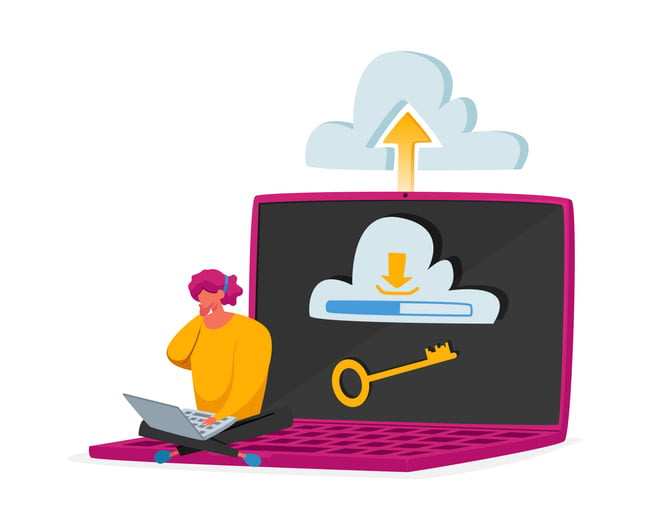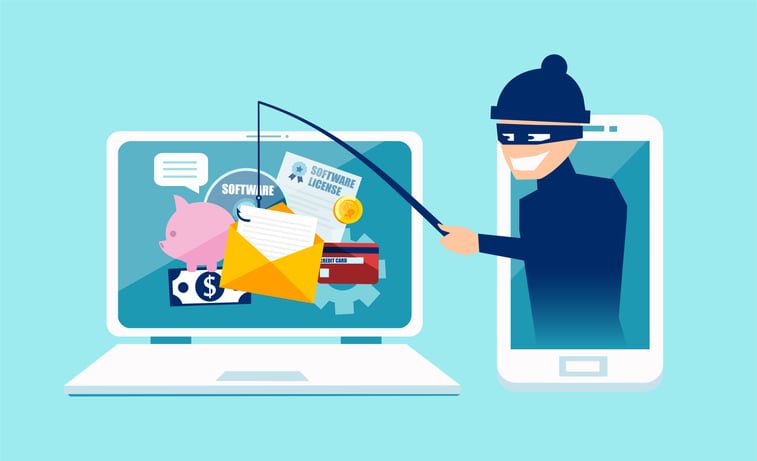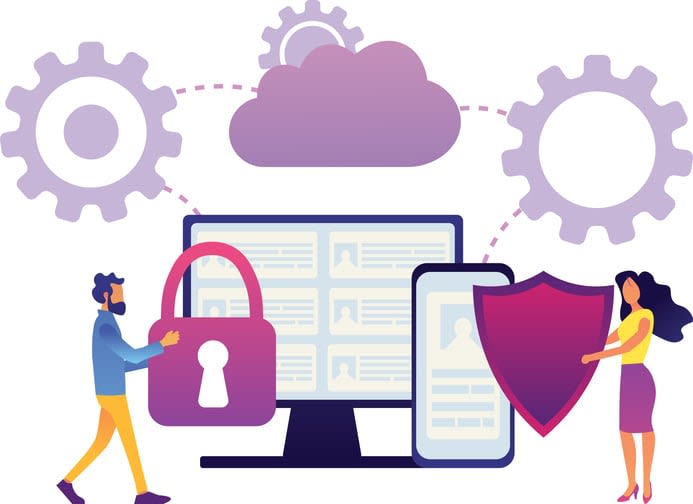Imagine you’re in an important business meeting, sharing trade secrets and crucial strategies. Suddenly, an unknown person joins your meeting, gaining access to your sensitive information. This is a real threat in the digital age, where communication has shifted online, and cyber threats are increasingly commonplace. Ensuring secure communication is no longer a luxury but a necessity. Let’s embark on this journey with Kumospace, a platform committed to securing your digital interactions and providing you with the tools and knowledge to protect your sensitive data.
Key takeaways
- Understand the four pillars of secure communication - encryption, authentication, integrity and non-repudiation.
- Utilize secure technology such as end-to-end encryption to protect emails from cyber threats.
- Evaluate security features such as encryption methods and privacy policies when selecting a reliable VPN service for maximum security.
Unlocking the pillars of secure communication
Although securing your digital communication might feel as complex as decoding an enigma, understanding the four fundamental principles can simplify it. These pillars - encryption, authentication, integrity, and non-repudiation - form the foundation of secure communication, standing guard to protect your sensitive data.
Focusing on the first principle, we can compare encryption to a secret language shared exclusively between the sender and recipient. Through the use of an encryption algorithm, data is scrambled into an unreadable format, ensuring it remains confidential during transmission.
Next is authentication, the digital equivalent of a secret handshake. It verifies the identity of users or devices, preventing unauthorized access.
The third principle, integrity, ensures that the data remains unaltered during transmission, serving as the guardian of truthfulness.
Finally, non-repudiation acts as a digital signature, providing proof of the sender’s identity and preventing them from denying their actions. Mastering these four principles is your first step towards mastering secure communication.
Critical to understand is that these principles are not standalone solutions, but rather, they work in tandem to fortify your communication security. Think of them as sentinels, each with a unique role but working collectively to safeguard your castle of communication.
Understanding these principles will better equip you for secure navigation in the digital landscape.
The role of encryption algorithms
If we compare secure communication to a castle, then encryption algorithms become the moat that safeguards it from invaders. They convert plain text into an unintelligible format, shielding sensitive data from prying eyes. From Triple DES to AES, these encryption algorithms are like a myriad of secret languages, each with a unique way of scrambling data to protect it from unauthorized users. Some common encryption algorithms include:
- Triple DES
- AES (Advanced Encryption Standard)
- RSA (Rivest-Shamir-Adleman)
- Blowfish
- Twofish
These algorithms play a crucial role in ensuring the security and privacy of our digital communications.
The beauty of these encryption algorithms lies in their ability to ensure the confidentiality and integrity of your communications. They transform your sensitive data into a cryptic puzzle that only the intended recipient can solve, thereby safeguarding your data during transmission. Whether you’re sending a confidential email or sharing a private file, encryption algorithms work tirelessly behind the scenes to preserve the confidentiality and privacy of your digital communication.
Authentication: the gatekeeper of secure communications

Authentication in secure communications serves a role similar to a gatekeeper, ensuring entry only to authorized individuals. It verifies the identity of the parties involved and acts as a barrier to unauthorized access. In the digital realm, this gatekeeper takes many forms, including two-factor authentication and biometrics.
Two-factor authentication adds an extra layer of security, using time-sensitive token generators or passcodes to protect against identity theft and data loss. On the other hand, biometrics uses unique physical or behavioral traits, such as:
- fingerprints
- voice patterns
- facial recognition
- iris scans
to provide enhanced protection. It’s like a digital fingerprint, unique to each user and difficult to reproduce.
With these gatekeepers in place, you can rest assured that your communications are safeguarded from unauthorized individuals trying to gain access.
Digital signatures and non-repudiation
Digital signatures, along with non-repudiation, act as the final seal of secure communication. Digital signatures verify the authenticity of a message, similar to how a wax seal in medieval times authenticated a letter. Non-repudiation, on the other hand, prevents the sender from denying their message, providing undeniable proof of origin.
These principles play a pivotal role in ensuring the integrity and authenticity of messages. With end-to-end encryption, even if an encrypted communication is intercepted, it remains an indecipherable cryptogram without the correct decryption key. Together, these elements form the final fortress in your secure communication setup, ensuring your messages remain tamper-proof and dispute-free.
Fortifying email: the vanguard of encrypted communication

In the era of digitization, email has become the cornerstone of communication. Yet, this convenience comes with risks. Emails can become a gateway for malicious attacks, including malware, phishing, and data breaches. The stakes are high, especially for businesses where a single breach can lead to a significant loss of sensitive data. So, how can we fortify this vanguard of communication?
The answer lies in encrypted email services, the digital equivalent of a lockbox for your sensitive emails. These services use end-to-end encryption to ensure that only the sender and intended recipient can access the email content. Moreover, businesses need to enforce secure logins to email servers and implement an email protection system capable of detecting and blocking malicious mail before it reaches the recipient.
However, the responsibility for securing communication doesn’t solely lie with the technology. The users play an equally important role. Awareness of potential phishing attacks and the use of strong passwords are simple yet effective measures users can take to bolster email security. A formidable defense for our emails can be created by combining secure technology with knowledgeable users.
Choosing encrypted email services
Choosing the correct encrypted email service is like selecting the appropriate armor for a battle. You need a service that prioritizes security, privacy, and user-friendly features. Services like:
- ProtonMail
- Tutanota
- Hushmail
- CounterMail
- Mailfence
Our company leads the pack in the realm of encrypted email services, utilizing secure sockets layer technology for enhanced security.
These services secure your emails by employing end-to-end encryption. This means your email messages are encrypted by the sender and can only be decrypted by the intended recipient, barring any unauthorized individuals from reading them. Unlike standard email services that leave your emails exposed, encrypted email services act as the armor that shields your emails from the arrows of cyber threats.
Preventing data breaches with email security tools
Email security tools serve as your arsenal in the fight against data breaches. Tools like Avanan, Abnormal, and Barracuda Email Protection, among others, provide protection against viruses, phishing, and account compromises, helping to minimize data leakage.
But how do these tools shield your data? Email encryption shields your data from interception, ensuring only the intended recipient can decipher it. Protection systems, on the other hand, deploy various security measures such as email filtering and anti-virus scanning to block malicious emails before they reach your inbox. Armed with these tools, you can confidently shield your emails from the onslaught of cyber threats.
Beyond text: securing diverse communication methods

In our interconnected world of today, communication extends beyond just text. Whether it’s voice, video, or file sharing, each form of communication has its own unique set of vulnerabilities. With cyber threats evolving and adapting, securing these diverse communication methods becomes a necessary hurdle to overcome.
Voice and video communications are not immune to cyber threats. Without proper security measures, your confidential conversations could be intercepted, leaving sensitive data exposed. Similarly, file sharing, a common practice in most businesses, poses a risk if not properly secured. Files shared during video meetings or via emails and text messages need to be protected with the same level of security as any other form of communication.
So, how can we secure these diverse communication methods? The answer lies in a combination of secure communication platforms, encryption technologies, and user education. By combining these elements, we can ensure comprehensive protection for all forms of communication.
Voice and video: ensuring confidential conversations
Imagine this scenario: You’re in a video conference, discussing confidential business strategies. Without proper security, your conversation could be intercepted, compromising your strategies and sensitive information. To combat this, encryption technologies are employed to secure your voice and video communications.
These technologies encrypt your data during transmission, ensuring only the designated participants can decrypt and access it. But that’s not all. To fully secure your voice and video communications, you need to be aware of potential threats and how to mitigate them. By staying vigilant and employing secure communication platforms, you can ensure your confidential conversations remain just that - confidential.
File sharing with confidence
Confidently sharing files can be compared to passing a secret note in a crowded room. You want assurance that only the intended recipient can read your note. Secure file sharing tools provide this assurance by encrypting your data and ensuring only the intended recipient can decrypt it.
However, using secure file sharing tools is just one piece of the puzzle. You also need to be aware of potential threats and how to mitigate them. By combining secure tools with informed practices, you can share files with the confidence that your sensitive information remains secure.
Navigating secure messaging apps

Messaging apps have become an integral part of our digital communication. However, these apps can also be a gateway for cyber threats, making secure messaging apps an essential tool for digital communication. With end-to-end encryption, these apps ensure that your messages are only accessible to the sender and the intended recipient, providing a secure platform for your digital interactions.
Some secure messaging apps include:
- Signal
- WhatsApp (with end-to-end encryption enabled)
- Telegram (with secret chats enabled)
- Wickr
- Threema
Using these secure messaging apps can help protect your privacy and ensure that your messages are secure.
But how can one navigate through the world of secure messaging apps? It’s all about evaluating their security features, including encryption methods and privacy policies. Secure messaging platforms such as Signal, WhatsApp, and Telegram employ robust encryption protocols to safeguard your data and conversations.
Choosing the correct secure messaging app is similar to finding the right key for a lock. You need to evaluate each app based on its encryption methods, privacy policies, and user-friendly features. By doing so, you can find the best fit for your needs and ensure your messages remain secure.
Evaluating secure messaging platforms
When evaluating secure messaging platforms, it’s important to consider their encryption methods, privacy policies, and user-friendly features. From end-to-end encryption to public-key encryption, these platforms offer a variety of encryption methods to secure your messages.
Privacy policies are another crucial factor when evaluating secure messaging platforms. These policies determine how your data is handled and who can access it.
Lastly, user-friendly features such as intuitive design and ease of use can greatly enhance your messaging experience. By considering these factors, you can choose a secure messaging platform that best fits your needs.
The advantages of end-to-end encryption
In the domain of secure messaging, end-to-end encryption takes the crown. It ensures that only the sender and intended recipient can access and read messages, providing a shield for your digital interactions.
End-to-end encryption offers numerous advantages in digital communications. It ensures that your data remains confidential, enhances data integrity, safeguards against unauthorized access, and fortifies cloud security. With end-to-end encryption, you can communicate securely, knowing that your messages are protected from prying eyes.
The virtual shield: VPNs and internet security

In the wide expanse of the internet, a VPN serves as a virtual shield, guarding your online activities and sensitive data from cyber threats. A VPN encrypts your internet connection and routes your data through a secure server, providing a shield against cyber threats.
But what is the working mechanism of VPNs? A VPN establishes a secure and encrypted connection between your device and the VPN server. All your data is directed through this secure tunnel, ensuring your online activities remain private.
Choosing a VPN is similar to selecting the appropriate shield for a battle. You need a VPN that prioritizes security, privacy, and performance. Services like ExpressVPN and NordVPN are known for their robust security features, providing a solid shield for your internet security.
The mechanics of VPNs
Understanding how a VPN works can be simplified by visualizing a secret tunnel that connects your device to the internet. This tunnel, created by the VPN, encrypts your data and keeps your online activities private.
VPNs employ various encryption methods, such as Advanced Encryption Standard (AES), public-key encryption, and transport layer security (TLS), to secure your data. By creating a secure tunnel and utilizing robust encryption methods, VPNs provide a secure pathway for your data, keeping your online activities secure and private.
Selecting a VPN for maximum security
Choosing a VPN for maximum security is akin to opting for a trusted guardian for your online activities. You need a VPN that provides robust security features, prioritizes user privacy, and delivers reliable performance.
Services like ExpressVPN and NordVPN lead the pack in terms of security and privacy. These services employ robust encryption protocols, provide a wide range of server locations, and offer user-friendly features. By choosing a reliable VPN, you can enhance your internet security and surf the web with peace of mind.
Mastering secure communication with Kumospace

With the understanding of secure communication principles, tools, and technologies, you are now ready to master secure communication with Kumospace. Kumospace provides guidance on various methods and technologies to ensure your communications remain confidential and protected from cyber threats.
Kumospace advocates for the use of end-to-end encryption and access control for communication security. Additionally, Kumospace provides information on secure messaging platforms designed to safeguard your sensitive information.
By adhering to Kumospace’s guide to communication security and using their suggested tools and technologies, you can securely navigate the digital landscape. Join Kumospace in mastering the art of secure communication and safeguarding your digital interactions.
Summary
Navigating the digital landscape can be a daunting experience, but with the right knowledge and tools, you can ensure your communications remain secure. From understanding the essential principles of secure communication to utilizing secure messaging apps, encrypted email services, and VPNs, you have the tools to protect your sensitive data. With Kumospace as your guide, you can master the art of secure communication and navigate the digital landscape with confidence.
Frequently asked questions
To ensure secure communication, use encryption protocols when sending messages and files over the internet, authenticate users, protect databases with firewalls or other security tools, and back up information in a secure location with restricted access.
Secure communication involves ensuring authentication of the communicating parties, as well as maintaining the confidentiality and integrity of the messages exchanged.
Secure communication is necessary to protect our personal data from exposure and ensure that the information we leave behind is kept private. Encrypting our communications keeps us safe by preventing outsiders from accessing sensitive data.
Encryption, authentication, integrity, and non-repudiation are the four essential principles of secure communication that ensure the safety and privacy of our data.
Examples of encryption algorithms include Triple DES, AES, RSA Security, Blowfish, and Twofish.





